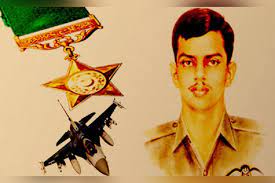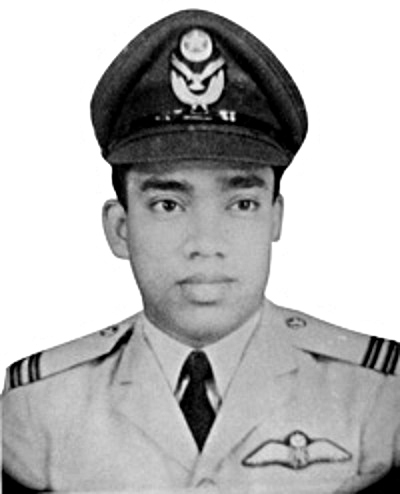
It was four months before the independence of Bangladesh when Flight Lt. Mutiur Rehman, who trained fighter pilots in the Pakistan Air Force, flew in the 1971 war in West Pakistan, present-day Pakistan.
During the 1971 war, Mutiur Rahman attempted to hijack a Pakistan Air Force fighter plane from Karachi and take it to India, but he failed in this attempt and the plane crashed near the Indian border, resulting in his death. The pilot-in-training was killed along with Rashid Minhas
After this incident, Pakistan awarded Rashid Minhas with Nishan Haider, the highest military honor of the country, while on the other hand, Bangladesh awarded Mutiur Rahman with the military honor of the best brave hero of his country. Mutiur Rehman belongs to a middle-class family of East Pakistan. He was born on 21 February 1945 in Ramna Nagar near Dhaka
And studied in the primary school there, after which he was admitted to PAF Public School in Sargodha in West Pakistan.
Mutiur Rehman’s joining PAF
After his 12th standard, he joined the Pakistan Air Force in August 1961
He was commissioned in the General Duty Pilot Branch in June 1963 and was training pilots before the 1971 war.
On the other hand, Rashid Minhas was born in February 1951 in Karachi after the partition of India, and in 1969 he joined the PF Academy Risalpur where he was trained to fly the Harvard and T-37 aircraft.
Qaiser Tufail, a historian of the Pakistani Air Force, writes in his book Bluebirds of Hijack that the Bengali officers stationed in Karachi realized that Pakistani intelligence was watching them.
The Bengali officers decided to maintain friendly relations with the officers at the air base but internally planned to hijack Pakistani warplanes and fly them to India.
Initially planning to hijack one or two F-86s, they abandoned it because the presence of more people might have raised suspicion.
In this article, Qaiser Tufail writes that it was determined that it would be easy to hijack a T-33 going on a solo mission.
On August 20, Rashid Manas had a hot breakfast in Rome near the squadron. He did not plan to fly that day.
How Rashid Minhas was sedated with chloroform
The weather near Karachi was too bad to go alone, but suddenly the weather improved, and Rashid Minhas was asked to prepare to fly. He went to get it, put on his flight clothes, quickly ate two gulab jamuns(The name of the sweet), and took two or three sips of Coca-Cola. The Pakistani authorities have been claiming that on August 20, Rashid Minhas was on a training flight with Muti-ur-Rehman. Muti-ur-Rehman signaled to them that there was a malfunction in the plane and made them semi-conscious by inhaling chloroform
Meanwhile, Mutiur Rahman asked his colleagues to deliver his family to the Indian High Commission in Karachi as they were taking a Pakistan Air Force plane to India.
According to the book Moon Glide published by ISPR, Pakistan Army’s public relations department, on August 20, 1971, Rashid Minhas was ready for take-off of the second flight of T-33 solo, he started the engine and ensured all safety measures.
The crew on the ground gave them a thumbs up, meaning they could take off
Rashid Minhas’ plane was signaled to stop by the Bengali instructor
As they prepared to take off, a Bengali instructor pilot, Flight Lieutenant Mutiur Rehman, signaled them to stop.
Rashid Minhas felt that he might be getting some extra instructions at the last minute
They intercepted the plane. Moonglide further states that Muti forced his way into the rear cockpit through the open canopy.
The control of the plane was taken away and the flight was turned towards India
Before Rashid Minhas knew it, the plane was on the runway. Qaiser Tufail writes that all Minhas could do was send a message to air traffic control at 11:28 a.m. that his plane had been hijacked.
According to him, Muti probably resorted to the pistol to put pressure on Rashid Minhas, otherwise, the engine could have been turned off as soon as he saw the danger.

Bengali officer Captain Farid wrote in a 2006 op-ed for the Daily Star newspaper that I could see the two pilots fighting for control of the plane.
I knew then that Muti was trying because he was not wearing a parachute or a helmet.
An alert was issued at the air base after the plane was hijacked
An alert was issued at the air base on the hijacking of the plane
Pakistani pilot Sajjad Haider wrote in his book Flight of the Falcon that Rashid had several options to abort take-off.
However, they could not do so. Mutiur Rahman was a very experienced pilot and flew at a low level to avoid the radars so that the planes sent behind could not find him.
However, later in the afternoon, a call was received from the local police station that a plane had met with an accident.
An investigation by the Air Investigation Board said the canopy was not locked during the flight It remained in place for some time under the pressure of the external air, then flew off in flight and hit the rear of the aircraft, causing the aircraft to fall on its nose.
Maybe that’s why Muti-ur-Rehman fell out of the cockpit because he didn’t have time to fasten his safety belt.
The crash investigation team found a toy pistol from the crash site and the body of Rashid Minhas was found inside the plane.
Pakistani authorities have claimed that Rashid Minhas tried to take back control of the plane from Matiaur Rehman and during this fight, the plane crashed near the Indian border.
The plane hit the ground near Thatta
Rashid Minhas deliberately brought down the plane and the accident took place near Thatta
Pakistani investigators later said after their investigation that Muti-ur-Rehman wanted to go to India with the plane so that he could support his colleagues in Bangladesh.
Air Investigation Board head Group Captain Zaheer Hussain also believed that the young and less experienced Rashid Minhas must have frozen in the cockpit.
Rashid Minhas was awarded Nishan e Haider
When the then military president Yahya Khan was told the whole story, he said that this boy deserved no less than Nishan e Haider.
Later, Rashid Minhas was awarded Nishan e Haider, the highest military award by the Government of Pakistan
Rashid Minhas is the only member of the SPAF and the youngest person to be awarded the Nishan e Haider, the highest military honor in Pakistan.
According to author Rafi Alam, who wrote on the history of Bangladesh, Muti-ur-Rehman decided on a secret mission court-named Bluebird to counter-insurgency against West Pakistan. No radar could track the hijacked T-33 aircraft because they flew at such a low altitude.
Muti-ur-Rehman wanted to take him to the airfield in Gujarat but failed to do so. He writes that Muti-ur-Rehman’s body was found near the crash site. Buried in the cemetery, his wife and two sons were detained by the Air Force for a month and released on 29 September 1971.
After the independence of Bangladesh, Mutiur Rehman was given the country’s highest military honor while the Bangladesh Air Force base in Jeswar was named after him.
In 2006, Mutiur Rehman’s body was handed over to Bangladesh after 35 years
Muti-ur-Rehman’s remains were initially buried in Karachi, Pakistan, but at the request of the Bangladeshi government, in 2006, Pakistan returned Muti-ur-Rehman’s remains to Bangladesh and buried them in Dhaka, 35 years after the establishment of Bangladesh. I was buried with military honors
